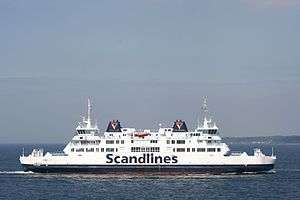MF Tycho Brahe
M/F Tycho Brahe is a Danish battery-electric car-ferry, that operates on the HH Ferry route between Helsingør, Denmark and Helsingborg, Sweden, a distance of just 5 km. M/F Tycho Brahe has been in use since 1991. The ship is bidirectional, therefore it can change direction without turning around, so no time is lost for this. The ship is also able to accelerate and decelerate quite quickly to and from her maximum speed of 14 knots.
 Tycho Brahe in 2007 | |
| History | |
|---|---|
| Name: | 1991 onwards: Tycho Brahe |
| Operator: |
|
| Port of registry: |
1991 onwards: Helsingør, |
| Builder: | Langsten Slip & Båtbyggeri, Tomrefjord, Norway |
| Yard number: | 156 |
| Launched: | 1991 |
| Identification: | IMO number: 9007116[1] |
| Status: | In service |
| General characteristics | |
| Tonnage: | 11,148 GT[2] |
| Length: | 111.20 m (364 ft 10 in)[2] |
| Beam: | 28.20 m (92 ft 6 in)[2] |
| Draught: | 5.50 m (18 ft 1 in)[2] |
| Installed power: | Electric |
| Propulsion: | 4×1.5 MW |
| Speed: | 14.5 knots[2] |
| Capacity: |
|
The ship is named after the Danish astronomer Tycho Brahe. M/F Tycho Brahe was built by Langsten Slip & Båtbyggeri in Tomrefjord, Norway. Currently, the ship is owned by Scandlines A/S and operated by ForSea (was Scandlines GmbH). Between 1991 and 1997, M/F Tycho Brahe was owned by DSB Rederi.
The ferry can carry 1250 passengers, and either 260 trucks, 240 cars or 9 passenger train coaches at one time. It was built with three railtracks inside, with a total length of 266 meters.
Conversion to electric
M/F Tycho Brahe has a sister ship, M/S Aurora af Helsingborg. The two ships were originally diesel-powered, but were converted in 2017 to full electric propulsion with 4 MWh batteries each, located between the chimneys. The batteries are recharged from land by a robot arm when docked,[3] at 10.5 MW (10.5 kV, 600 Ampere) for 6 minutes in Denmark and 9 minutes in Sweden. Each trip uses about 1,175 kWh, and is scheduled to last 20 minutes similarly to the diesel ferries.[4] Two of the four Wärtsilä-Vasa 6R32E diesel engines have been removed from each ship, with the other two as a backup system, not for daily operation.[5]
Main specifications:
- Length: 111 m/364 ft 2 in
- Beam: 28,2 m/92 ft 6 in
- Draft: 5,7 m/18 ft 8 in
- Tonnage: 12000 gt
- Machinery: 4 thrusters of 1.5 MW each, 4.1 MWh Li-ion batteries.[6] Backup system: two-shaft, diesel, 3350 hp
- Tycho Brahe after conversion
.jpg) Tycho Brahe in 2018
Tycho Brahe in 2018 Batteries on top
Batteries on top.jpg) Tycho Brahe in 2019
Tycho Brahe in 2019
Gallery
References
- Faktaomfartyg.se "M/S Tycho Brahe", accessed 21 April 2011
- Scandlines "Routes, Ferries & Ports 2011", accessed 21 April 2011
- https://electrek.co/2017/08/24/all-electric-ferries-abb/
- "Sustainability". ForSea Ferries. Archived from the original on 23 June 2019.
- http://www.tu.no/artikler/89-tonn-batterier-i-verdens-storste-el-ferge/348995
- https://fullycharged.show/episodes/100-electric-ferry-crossing/
- The Encyclopedia of ships. General editor: Tony Gibbons. Silverdale books, 2002, ISBN 1-85605-591-4. Page 216.
External links
- M/F Tycho Brahe
- Forsea ferries
- Fully charged show on electric ferries
- Electrek: Two massive ferries are about to become the biggest all-electric ships in the world

.jpg)